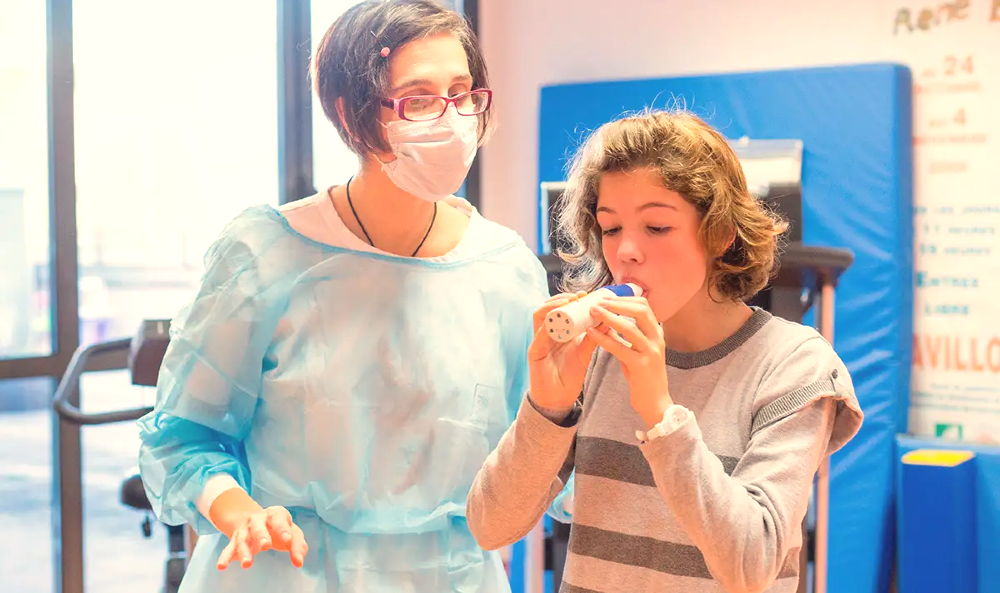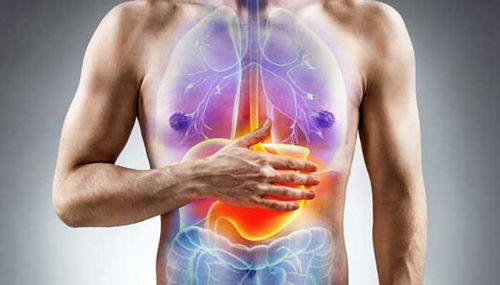Cystic fibrosis is a congenital disease that causes certain glands to secrete abnormal secretions; many symptoms result. The main ones affect the gastrointestinal tract and lungs.
CYSTIC FIBROSIS: General | Symptoms | Diagnosis | Forecast | Treatment | Questions and Answers | Sources/references
Cystic fibrosis is the most common congenital metabolic disease in Central Europe and the most common congenital disease causing death among Caucasians in the United States. In the United States, 1 in 2,500 white children and 1 in 17,000 black children are born with it. It is rare in people of Asian descent. It is equally common in boys and girls. Many patients with cystic fibrosis die young, but 35 percent of Americans with cystic fibrosis live into adulthood.
About 5 percent of Caucasians carry one defective gene responsible for cystic fibrosis, but the trait is recessive, and the disease only develops if a person has two defective genes. People with a single defective gene have no noticeable symptoms. The gene regulates the production of a protein that regulates the transfer of chloride and sodium (salt) through the cell membrane. If both genes are abnormal, chloride and sodium transport is impaired; this leads to dehydration and increases the stickiness of secretions.
Picture: Older children and adults perform respiratory therapy independently.

Cystic fibrosis affects almost all exocrine glands (glands that release secretions into the body). The secretions are abnormal in various ways and adversely affect the functioning of the glands. In some glands, e.g., in the pancreas and glands in the intestines, the secretions are thick or solid and may completely block the gland. Mucous glands in the airways produce abnormal secretions, which clog the airways and allow bacteria to multiply. Sweat glands and salivary glands secrete a liquid with more salt than usual.
Symptoms
Lungs are normal at birth, but breathing problems can occur anytime after birth. Thick secretions from the trachea eventually clog the small airways, which then become inflamed. As the disease progresses, the tracheal walls thicken, the airways fill with infected secretions, parts of the lungs shrink (such contractions are called atelectasis), and the lymph nodes enlarge. All these changes reduce the ability of the lungs to transfer oxygen to the blood.
Meconium ileus, a form of intestinal obstruction in newborns, occurs in 17 percent of people with cystic fibrosis. Meconium, the dark green substance passed as a newborn's first stool, is thick and moves more slowly than usual. If the meconium is too thick, it blocks the intestine. A blockage can cause a perforation of the intestinal wall or a "bowel tie." Meconium can create plugs in the colon or buttocks, causing a transient obstruction. People who experience meconium ileus as infants almost always develop other symptoms of cystic fibrosis later.
Image: Parents sometimes notice the formation of salt crystals on their child's skin, or the skin has a salty taste.

The first symptom of cystic fibrosis in a baby who does not have meconium ileus is often poor weight gain around 4 to 6 weeks. Insufficient pancreatic secretions, necessary for the proper digestion of fats and proteins, cause indigestion in 85 to 90 percent of infants with cystic fibrosis. The child often passes copious foul-smelling, greasy stools and may have a bulging belly.
Despite a regular or large run, it grows slowly. He is thin and has flabby muscles. Insufficient absorption of fat-soluble vitamins - A, D, E, and K - can cause night blindness, rickets, anemia, and blood clotting disorders. In 20 percent of untreated infants and young children, the lining of the colon bulges through the buttocks; this is called rectal prolapse. Children fed soy protein preparations or breast milk may develop anemia and swelling because they do not absorb enough protein.
Approximately half of children with cystic fibrosis are taken to the doctor for the first time because they keep coughing, wheezing, and experiencing respiratory infections. Coughing, the most noticeable symptom, is often accompanied by heaving, vomiting, and disturbed sleep. As the disease progresses, the chest becomes barrel-shaped, and webbed fingers and bluish skin may appear due to lack of oxygen.
Teenagers often grow slowly, have delayed puberty, and their physical endurance declines. Among complications in adults and adolescents include collapsed lungs (pneumothorax), coughing up blood, and heart failure. Infections are also a big problem. Recurrent bronchitis and pneumonia gradually destroy the lungs. Death usually results from a combination of respiratory failure and heart failure due to underlying lung disease.
About 2 to 3 percent of cystic fibrosis patients develop insulin-dependent diabetes because the scarred pancreas does not produce enough insulin. Clogging of the bile ducts with thick secretions can provoke inflammation of the liver and, eventually, cirrhosis. Cirrhosis can cause increased pressure in the veins that carry the wind (portal hypertension) and the formation of enlarged, fragile veins in the lower part of the esophagus (esophageal varices). These disease-altered veins sometimes bleed very heavily.
Video content: Cystic fibrosis - symptoms, inheritance, treatment and more.

Patients with cystic fibrosis often have impaired reproductive function. Among adult men, 98 percent are those who do not produce sperm at all or have an insufficient number of sperm because their vas deferens have developed abnormally.
In women, cervical secretions are too thick and reduce fertility. Complications during pregnancy are more likely in patients with cystic fibrosis than in healthy women, but many women with cystic fibrosis have children. When a person with cystic fibrosis sweats profusely or has a fever in hot weather, they may experience dehydration due to increased loss of salt and water. Parents sometimes notice the formation of salt crystals on their child's skin, or the skin even has a salty taste.
Diagnosis
Newborns with cystic fibrosis have a high concentration of the digestive enzyme trypsin in their blood. Trypsin concentration can be measured in a small drop of blood on a filter paper. Although this method is used for newborn screening, it is not a definitive test for cystic fibrosis.
Quantitative pilocarpine sweat iontophoresis is a test that measures the amount of salt in sweat. The subject is given the drug pilocarpine to stimulate sweating on a small area of the skin, and a piece of sweat-absorbing filter paper is placed on the skin. Then they determine the concentration of salt in the sweat.
A salt concentration that exceeds normal confirms the diagnosis in people who have symptoms of cystic fibrosis or a close relative with the disease. The test result is valid if performed on a child older than 24 hours, but obtaining a large enough sweat sample for a child younger than three to four weeks is often tricky. Sweat iontophoresis is also helpful in confirming the diagnosis in older children and adults.
Image: More than 75 percent of people with CF are diagnosed by age 2.

Since cystic fibrosis can affect several organs, the doctor uses several other tests to help diagnose the disease. If the concentration of pancreatic enzymes is decreased, examination of the patient's stool may reveal little or no digestive enzymes, trypsin, chymotrypsin, or high fat. If insulin secretion is reduced, the sugar concentration in the blood is high.
Pulmonary function tests A may show respiratory impairment. An X-ray of the chest organs also helps to establish the diagnosis. Relatives of a child with cystic fibrosis may be interested in whether they can have a child with this disease. Genetic testing of a small blood sample can help identify defective cystic fibrosis gene carriers.
If both potential parents do not have at least one such gene, their children will not have cystic fibrosis. If both are carriers of the defective gene, there is a 25% chance that a child with cystic fibrosis will be born with each pregnancy. As a rule, an accurate diagnosis of cystic fibrosis in the fetus can be established already during pregnancy.
Forecast
The severity of cystic fibrosis varies significantly from person to person, regardless of age. How severe the disease is depends mainly on how affected the lungs are. However, deterioration is inevitable and leads to debilitation and, ultimately, death. Despite this, the prognosis of patients has steadily improved over the past 25 years, mainly because treatment can now delay some of the changes in the lungs.
Video content: Life with cystic fibrosis.

Half of patients with cystic fibrosis live more than 28 years. Long-term survival is slightly better in men, people without pancreatic problems, and those whose initial symptoms are limited to the gastrointestinal tract. Despite many problems, patients with cystic fibrosis usually go to school or work almost until death. Gene therapy is very promising for cystic fibrosis.
Treatment
Therapy includes preventing and treating lung problems, good nutrition, physical activity, and psychological and social support. Most of the burden of the child's treatment remains on the shoulders of the parents. Parents must receive adequate information to understand the disease and the reasons for treatment.
The patient must receive a comprehensive therapeutic program led by an experienced physician involving nurses, a dietician, a social worker, a physiotherapist, and a respiratory therapist. A particular type of enema can resolve uncomplicated meconium ileus; surgery may be necessary if the enema is not adequate. Regular intake of medicines that draw fluid into the intestines (e.g., lactulose) prevents stool from clogging the digestive tract.
Patients with impaired pancreatic function must take replacement enzymes with each meal; supplements are available in powder (for babies) and capsules. The diet must provide enough calories and protein for average growth. The proportion of fat should be expected to be high. Because cystic fibrosis patients do not absorb fats well, they must consume more than average amounts to ensure adequate growth.
In addition, they must consume double the usual daily dose of multivitamin preparations and take a water-soluble preparation of vitamin E. They must take salt supplements during physical exertion, heat, or hot weather. Special milk preparations with proteins and fats that are easy to digest can help babies with severe pancreas problems. Children who cannot feed themselves properly need additional feeding through a tube inserted into the stomach or small intestine.
Image: Patients are often given medication to help prevent the narrowing of the airways.
.jpg)
Treatment for lung problems focuses on preventing airway obstruction and controlling infections. Patients must have all the usual vaccinations and, in addition, be vaccinated against the flu, as viral infections can further damage the lungs. Respiratory therapy - which includes postural drainage, percussion and vibration, and assisted coughing - should be started at the first signs of lung problems.
Parents of young children can learn these techniques and practice them daily at home. Older children and adults perform respiratory therapy independently; they use special breathing devices or compression jackets.
Patients are often given medicines that help prevent the narrowing of the airways (bronchodilators). Those with severe lung problems and low blood oxygen levels need oxygen therapy. In general, patients with respiratory failure do not benefit from being connected to a ventilator; however, short periods of mechanical ventilation sometimes help during severe infections if the patient's lungs function correctly before the infection.
Sprays of drugs that thin mucus (mucolytics) are widely used, e.g., recombinant human DNase, because they facilitate expectoration and improve lung function. They also reduce the frequency of severe lung infections. There is no proven benefit for mist tents. Corticosteroids can relieve symptoms in infants with severe bronchial inflammation and in patients with narrowed airways that cannot be widened with bronchodilators. Some NSAIDs are sometimes used to slow down the deterioration of lung function, e.g., ibuprofen.
Lung infections should be treated early with antibiotics. At the first sign of infection, a sample of coughed-up sputum should be taken to identify the causative germ in the laboratory, and the doctor can choose the medicine that will most likely destroy it. The antibiotic can usually be taken; sometimes, they use the antibiotic tobramycin in a spray. However, if the infection is severe, intravenous antibiotics are needed. Treatment often requires hospital admission sessions but can also be done at home. Long-term use of antibiotics or the use of antibiotic sprays helps some patients to prevent recurrences of infections.
Sealing off the bleeding artery can treat massive or recurrent lung bleeding. Surgery may be necessary in case of collapse of a lung segment (pneumothorax), chronic infection of the nasal cavities, severe chronic infection in one part of the lungs, bleeding from veins in the esophagus, gallbladder disease, or intestinal obstruction.
Picture: The patient must have a comprehensive therapeutic program.
.jpg)
Liver transplantation was successful in severe liver damage. Transplantation of the heart and both lungs is done for severe heart failure and lung disease. These transplants are becoming more common and successful as experience increases and surgical techniques improve. One year after the transplant, approximately 75 percent of the patients are alive, and their condition is much better.
Cystic fibrosis patients usually die of respiratory failure after many years of deteriorating lung function. A small number of them die from liver disease, bleeding into the respiratory tract, or complications from surgery.
Questions and answers
How common is cystic fibrosis in Slovenia?
A gene mutation affects approximately 1 in 5,000 newborns annually, and every 25th person carries the mutation. If we take these data into account, 3 to 4 children with cystic fibrosis are born in Slovenia every year[1].
What causes cystic fibrosis?
It is caused by a defective gene that affects the movement of salt and water in and out of cells. This, along with repeated infections, can build up thick, sticky mucus in the body's tubes and passages—especially in the lungs and digestive system[2].
Is cystic fibrosis curable?
There is no cure for cystic fibrosis, but a range of treatments can help control symptoms, prevent or reduce complications, and make life easier. Regular doctor visits are required to monitor the condition, and a care plan will be prepared according to the person's needs[2].
Can cystic fibrosis be fatal?
Cystic fibrosis worsens over time and can be fatal if it causes a severe infection or the lungs stop working correctly. However, people with cystic fibrosis are now living longer because of advances in treatment. Currently, about half of people with cystic fibrosis will live beyond 40 years[2].
Is cystic fibrosis present at birth?
CF is an inherited disease. It is passed from parent to child through genes[3].
Sources and references
An extensive health manual for home use, Youth Book Publishing House
- What is cystic fibrosis - https://www.drustvocf.si
- Cystic fibrosis - https://www.nhs.uk
- Cystic fibrosis and your baby - https://www.marchofdimes.org













